Analysis of Indigenous Legal Traditions and Canadian Law
VerifiedAdded on 2022/11/15
|7
|1677
|191
Homework Assignment
AI Summary
This assignment explores the resilience of Indigenous legal traditions in the face of historical injustices, focusing on the Canadian context. It examines the unique legal systems, governance structures, and methods of social control employed by Indigenous communities, contrasting them with European legal frameworks. The analysis delves into the potential benefits of incorporating Indigenous laws into the Canadian legal system, such as cultural revitalization and the recognition of Indigenous decision-making. However, the assignment also acknowledges the significant challenges associated with this integration, including the need for Indigenous communities to define their traditions, the creation of legal and political space, and the complexities of applying the Canadian Charter of Rights and Freedoms. It also discusses challenges in interpreting and understanding Indigenous legal traditions, and the need for Canada to be receptive to these revitalized systems. The assignment references key readings, including Aboriginal Concepts of Justice, Indigenous Legal Traditions in Canada, and Justice Within: Indigenous Legal Traditions to support its arguments and offer a comprehensive overview of the topic.
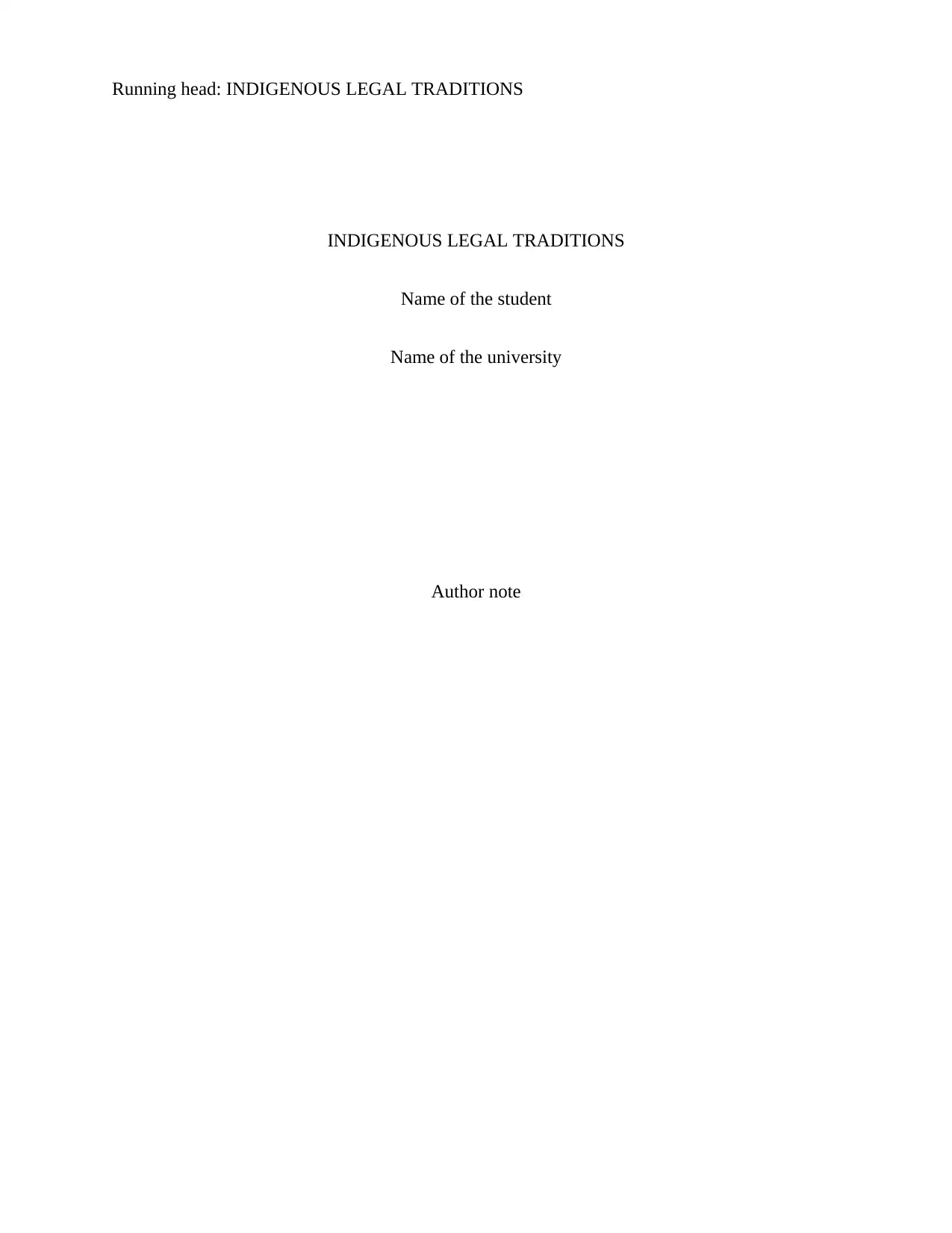
Running head: INDIGENOUS LEGAL TRADITIONS
INDIGENOUS LEGAL TRADITIONS
Name of the student
Name of the university
Author note
INDIGENOUS LEGAL TRADITIONS
Name of the student
Name of the university
Author note
Paraphrase This Document
Need a fresh take? Get an instant paraphrase of this document with our AI Paraphraser
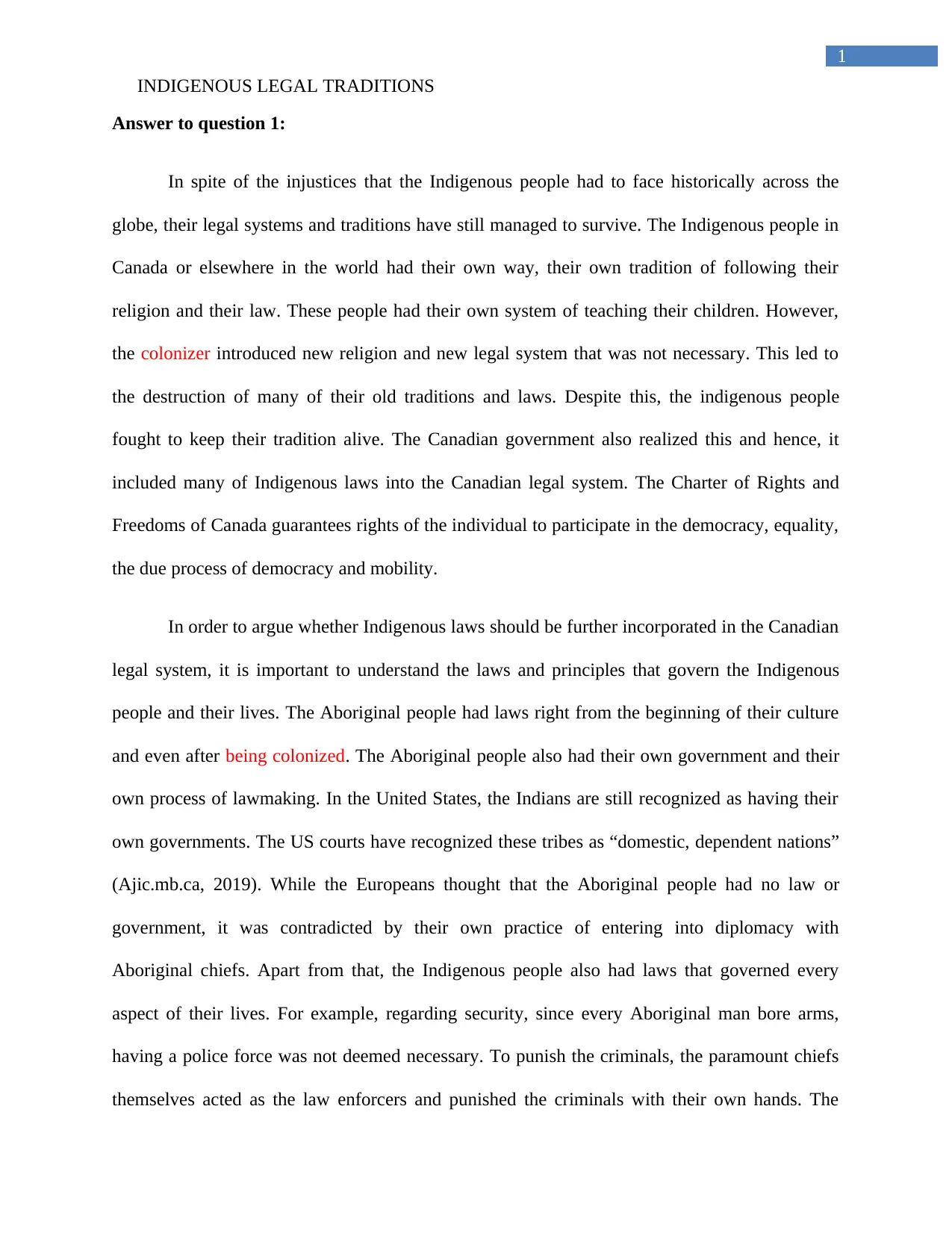
1
INDIGENOUS LEGAL TRADITIONS
Answer to question 1:
In spite of the injustices that the Indigenous people had to face historically across the
globe, their legal systems and traditions have still managed to survive. The Indigenous people in
Canada or elsewhere in the world had their own way, their own tradition of following their
religion and their law. These people had their own system of teaching their children. However,
the colonizer introduced new religion and new legal system that was not necessary. This led to
the destruction of many of their old traditions and laws. Despite this, the indigenous people
fought to keep their tradition alive. The Canadian government also realized this and hence, it
included many of Indigenous laws into the Canadian legal system. The Charter of Rights and
Freedoms of Canada guarantees rights of the individual to participate in the democracy, equality,
the due process of democracy and mobility.
In order to argue whether Indigenous laws should be further incorporated in the Canadian
legal system, it is important to understand the laws and principles that govern the Indigenous
people and their lives. The Aboriginal people had laws right from the beginning of their culture
and even after being colonized. The Aboriginal people also had their own government and their
own process of lawmaking. In the United States, the Indians are still recognized as having their
own governments. The US courts have recognized these tribes as “domestic, dependent nations”
(Ajic.mb.ca, 2019). While the Europeans thought that the Aboriginal people had no law or
government, it was contradicted by their own practice of entering into diplomacy with
Aboriginal chiefs. Apart from that, the Indigenous people also had laws that governed every
aspect of their lives. For example, regarding security, since every Aboriginal man bore arms,
having a police force was not deemed necessary. To punish the criminals, the paramount chiefs
themselves acted as the law enforcers and punished the criminals with their own hands. The
INDIGENOUS LEGAL TRADITIONS
Answer to question 1:
In spite of the injustices that the Indigenous people had to face historically across the
globe, their legal systems and traditions have still managed to survive. The Indigenous people in
Canada or elsewhere in the world had their own way, their own tradition of following their
religion and their law. These people had their own system of teaching their children. However,
the colonizer introduced new religion and new legal system that was not necessary. This led to
the destruction of many of their old traditions and laws. Despite this, the indigenous people
fought to keep their tradition alive. The Canadian government also realized this and hence, it
included many of Indigenous laws into the Canadian legal system. The Charter of Rights and
Freedoms of Canada guarantees rights of the individual to participate in the democracy, equality,
the due process of democracy and mobility.
In order to argue whether Indigenous laws should be further incorporated in the Canadian
legal system, it is important to understand the laws and principles that govern the Indigenous
people and their lives. The Aboriginal people had laws right from the beginning of their culture
and even after being colonized. The Aboriginal people also had their own government and their
own process of lawmaking. In the United States, the Indians are still recognized as having their
own governments. The US courts have recognized these tribes as “domestic, dependent nations”
(Ajic.mb.ca, 2019). While the Europeans thought that the Aboriginal people had no law or
government, it was contradicted by their own practice of entering into diplomacy with
Aboriginal chiefs. Apart from that, the Indigenous people also had laws that governed every
aspect of their lives. For example, regarding security, since every Aboriginal man bore arms,
having a police force was not deemed necessary. To punish the criminals, the paramount chiefs
themselves acted as the law enforcers and punished the criminals with their own hands. The
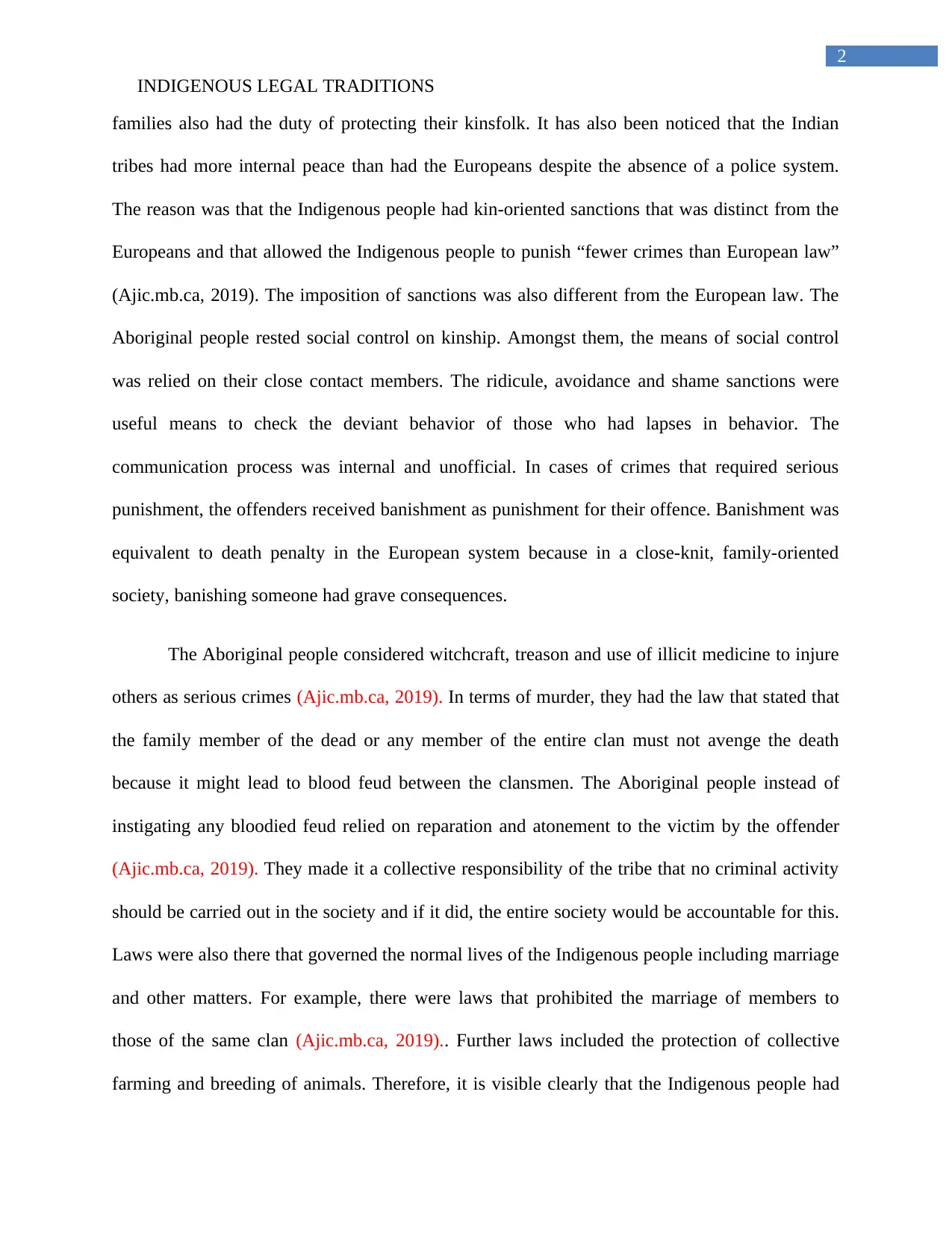
2
INDIGENOUS LEGAL TRADITIONS
families also had the duty of protecting their kinsfolk. It has also been noticed that the Indian
tribes had more internal peace than had the Europeans despite the absence of a police system.
The reason was that the Indigenous people had kin-oriented sanctions that was distinct from the
Europeans and that allowed the Indigenous people to punish “fewer crimes than European law”
(Ajic.mb.ca, 2019). The imposition of sanctions was also different from the European law. The
Aboriginal people rested social control on kinship. Amongst them, the means of social control
was relied on their close contact members. The ridicule, avoidance and shame sanctions were
useful means to check the deviant behavior of those who had lapses in behavior. The
communication process was internal and unofficial. In cases of crimes that required serious
punishment, the offenders received banishment as punishment for their offence. Banishment was
equivalent to death penalty in the European system because in a close-knit, family-oriented
society, banishing someone had grave consequences.
The Aboriginal people considered witchcraft, treason and use of illicit medicine to injure
others as serious crimes (Ajic.mb.ca, 2019). In terms of murder, they had the law that stated that
the family member of the dead or any member of the entire clan must not avenge the death
because it might lead to blood feud between the clansmen. The Aboriginal people instead of
instigating any bloodied feud relied on reparation and atonement to the victim by the offender
(Ajic.mb.ca, 2019). They made it a collective responsibility of the tribe that no criminal activity
should be carried out in the society and if it did, the entire society would be accountable for this.
Laws were also there that governed the normal lives of the Indigenous people including marriage
and other matters. For example, there were laws that prohibited the marriage of members to
those of the same clan (Ajic.mb.ca, 2019).. Further laws included the protection of collective
farming and breeding of animals. Therefore, it is visible clearly that the Indigenous people had
INDIGENOUS LEGAL TRADITIONS
families also had the duty of protecting their kinsfolk. It has also been noticed that the Indian
tribes had more internal peace than had the Europeans despite the absence of a police system.
The reason was that the Indigenous people had kin-oriented sanctions that was distinct from the
Europeans and that allowed the Indigenous people to punish “fewer crimes than European law”
(Ajic.mb.ca, 2019). The imposition of sanctions was also different from the European law. The
Aboriginal people rested social control on kinship. Amongst them, the means of social control
was relied on their close contact members. The ridicule, avoidance and shame sanctions were
useful means to check the deviant behavior of those who had lapses in behavior. The
communication process was internal and unofficial. In cases of crimes that required serious
punishment, the offenders received banishment as punishment for their offence. Banishment was
equivalent to death penalty in the European system because in a close-knit, family-oriented
society, banishing someone had grave consequences.
The Aboriginal people considered witchcraft, treason and use of illicit medicine to injure
others as serious crimes (Ajic.mb.ca, 2019). In terms of murder, they had the law that stated that
the family member of the dead or any member of the entire clan must not avenge the death
because it might lead to blood feud between the clansmen. The Aboriginal people instead of
instigating any bloodied feud relied on reparation and atonement to the victim by the offender
(Ajic.mb.ca, 2019). They made it a collective responsibility of the tribe that no criminal activity
should be carried out in the society and if it did, the entire society would be accountable for this.
Laws were also there that governed the normal lives of the Indigenous people including marriage
and other matters. For example, there were laws that prohibited the marriage of members to
those of the same clan (Ajic.mb.ca, 2019).. Further laws included the protection of collective
farming and breeding of animals. Therefore, it is visible clearly that the Indigenous people had
⊘ This is a preview!⊘
Do you want full access?
Subscribe today to unlock all pages.

Trusted by 1+ million students worldwide
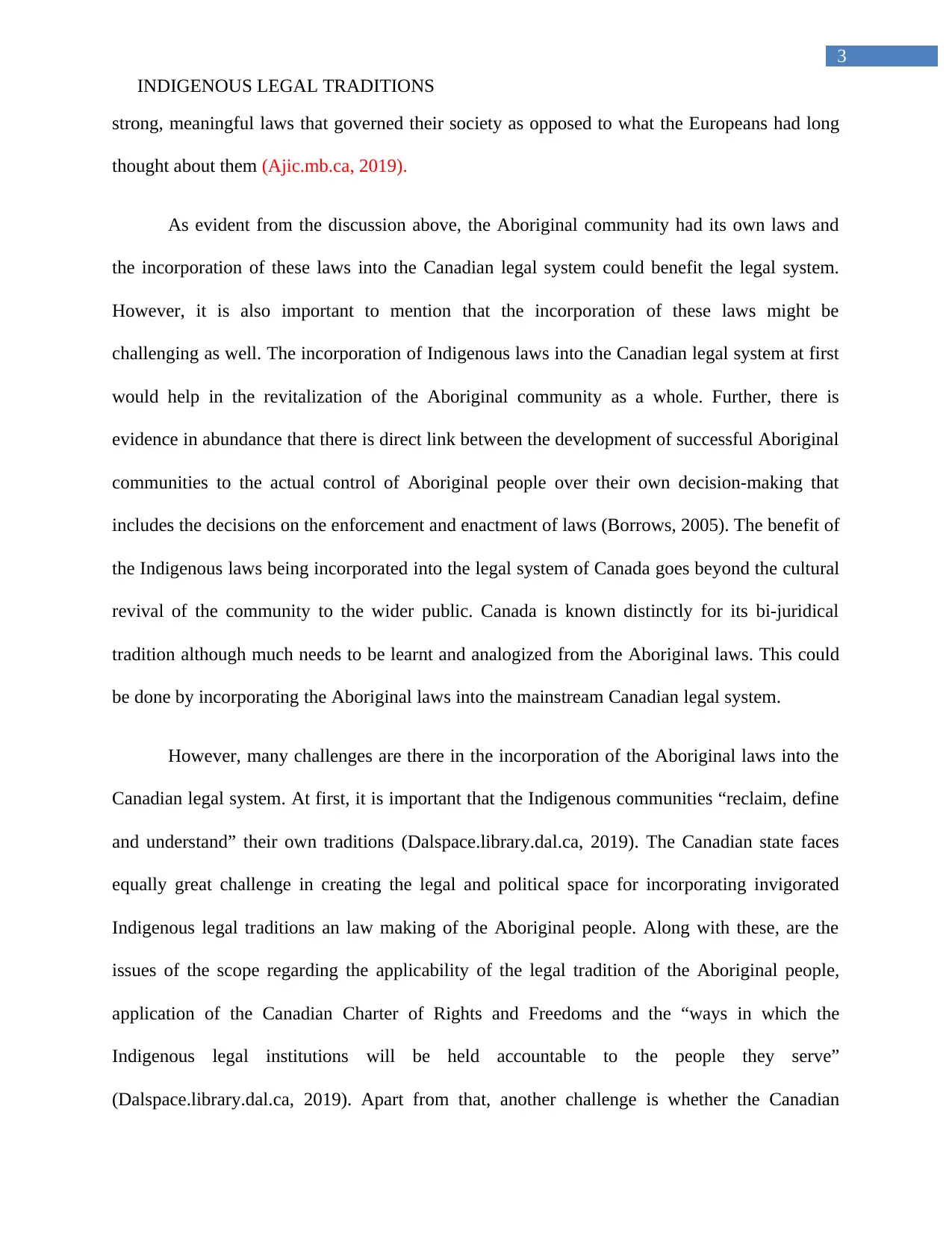
3
INDIGENOUS LEGAL TRADITIONS
strong, meaningful laws that governed their society as opposed to what the Europeans had long
thought about them (Ajic.mb.ca, 2019).
As evident from the discussion above, the Aboriginal community had its own laws and
the incorporation of these laws into the Canadian legal system could benefit the legal system.
However, it is also important to mention that the incorporation of these laws might be
challenging as well. The incorporation of Indigenous laws into the Canadian legal system at first
would help in the revitalization of the Aboriginal community as a whole. Further, there is
evidence in abundance that there is direct link between the development of successful Aboriginal
communities to the actual control of Aboriginal people over their own decision-making that
includes the decisions on the enforcement and enactment of laws (Borrows, 2005). The benefit of
the Indigenous laws being incorporated into the legal system of Canada goes beyond the cultural
revival of the community to the wider public. Canada is known distinctly for its bi-juridical
tradition although much needs to be learnt and analogized from the Aboriginal laws. This could
be done by incorporating the Aboriginal laws into the mainstream Canadian legal system.
However, many challenges are there in the incorporation of the Aboriginal laws into the
Canadian legal system. At first, it is important that the Indigenous communities “reclaim, define
and understand” their own traditions (Dalspace.library.dal.ca, 2019). The Canadian state faces
equally great challenge in creating the legal and political space for incorporating invigorated
Indigenous legal traditions an law making of the Aboriginal people. Along with these, are the
issues of the scope regarding the applicability of the legal tradition of the Aboriginal people,
application of the Canadian Charter of Rights and Freedoms and the “ways in which the
Indigenous legal institutions will be held accountable to the people they serve”
(Dalspace.library.dal.ca, 2019). Apart from that, another challenge is whether the Canadian
INDIGENOUS LEGAL TRADITIONS
strong, meaningful laws that governed their society as opposed to what the Europeans had long
thought about them (Ajic.mb.ca, 2019).
As evident from the discussion above, the Aboriginal community had its own laws and
the incorporation of these laws into the Canadian legal system could benefit the legal system.
However, it is also important to mention that the incorporation of these laws might be
challenging as well. The incorporation of Indigenous laws into the Canadian legal system at first
would help in the revitalization of the Aboriginal community as a whole. Further, there is
evidence in abundance that there is direct link between the development of successful Aboriginal
communities to the actual control of Aboriginal people over their own decision-making that
includes the decisions on the enforcement and enactment of laws (Borrows, 2005). The benefit of
the Indigenous laws being incorporated into the legal system of Canada goes beyond the cultural
revival of the community to the wider public. Canada is known distinctly for its bi-juridical
tradition although much needs to be learnt and analogized from the Aboriginal laws. This could
be done by incorporating the Aboriginal laws into the mainstream Canadian legal system.
However, many challenges are there in the incorporation of the Aboriginal laws into the
Canadian legal system. At first, it is important that the Indigenous communities “reclaim, define
and understand” their own traditions (Dalspace.library.dal.ca, 2019). The Canadian state faces
equally great challenge in creating the legal and political space for incorporating invigorated
Indigenous legal traditions an law making of the Aboriginal people. Along with these, are the
issues of the scope regarding the applicability of the legal tradition of the Aboriginal people,
application of the Canadian Charter of Rights and Freedoms and the “ways in which the
Indigenous legal institutions will be held accountable to the people they serve”
(Dalspace.library.dal.ca, 2019). Apart from that, another challenge is whether the Canadian
Paraphrase This Document
Need a fresh take? Get an instant paraphrase of this document with our AI Paraphraser
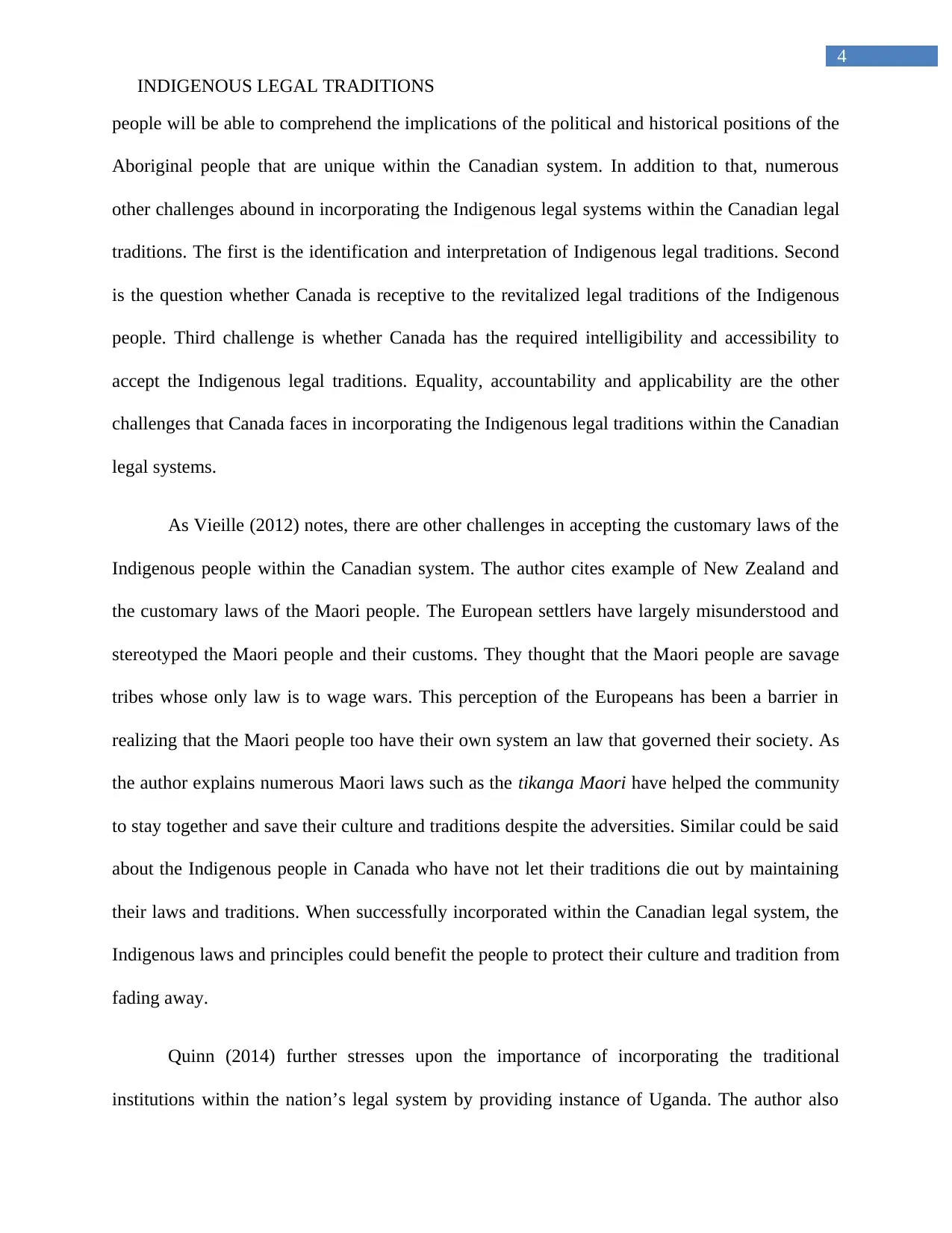
4
INDIGENOUS LEGAL TRADITIONS
people will be able to comprehend the implications of the political and historical positions of the
Aboriginal people that are unique within the Canadian system. In addition to that, numerous
other challenges abound in incorporating the Indigenous legal systems within the Canadian legal
traditions. The first is the identification and interpretation of Indigenous legal traditions. Second
is the question whether Canada is receptive to the revitalized legal traditions of the Indigenous
people. Third challenge is whether Canada has the required intelligibility and accessibility to
accept the Indigenous legal traditions. Equality, accountability and applicability are the other
challenges that Canada faces in incorporating the Indigenous legal traditions within the Canadian
legal systems.
As Vieille (2012) notes, there are other challenges in accepting the customary laws of the
Indigenous people within the Canadian system. The author cites example of New Zealand and
the customary laws of the Maori people. The European settlers have largely misunderstood and
stereotyped the Maori people and their customs. They thought that the Maori people are savage
tribes whose only law is to wage wars. This perception of the Europeans has been a barrier in
realizing that the Maori people too have their own system an law that governed their society. As
the author explains numerous Maori laws such as the tikanga Maori have helped the community
to stay together and save their culture and traditions despite the adversities. Similar could be said
about the Indigenous people in Canada who have not let their traditions die out by maintaining
their laws and traditions. When successfully incorporated within the Canadian legal system, the
Indigenous laws and principles could benefit the people to protect their culture and tradition from
fading away.
Quinn (2014) further stresses upon the importance of incorporating the traditional
institutions within the nation’s legal system by providing instance of Uganda. The author also
INDIGENOUS LEGAL TRADITIONS
people will be able to comprehend the implications of the political and historical positions of the
Aboriginal people that are unique within the Canadian system. In addition to that, numerous
other challenges abound in incorporating the Indigenous legal systems within the Canadian legal
traditions. The first is the identification and interpretation of Indigenous legal traditions. Second
is the question whether Canada is receptive to the revitalized legal traditions of the Indigenous
people. Third challenge is whether Canada has the required intelligibility and accessibility to
accept the Indigenous legal traditions. Equality, accountability and applicability are the other
challenges that Canada faces in incorporating the Indigenous legal traditions within the Canadian
legal systems.
As Vieille (2012) notes, there are other challenges in accepting the customary laws of the
Indigenous people within the Canadian system. The author cites example of New Zealand and
the customary laws of the Maori people. The European settlers have largely misunderstood and
stereotyped the Maori people and their customs. They thought that the Maori people are savage
tribes whose only law is to wage wars. This perception of the Europeans has been a barrier in
realizing that the Maori people too have their own system an law that governed their society. As
the author explains numerous Maori laws such as the tikanga Maori have helped the community
to stay together and save their culture and traditions despite the adversities. Similar could be said
about the Indigenous people in Canada who have not let their traditions die out by maintaining
their laws and traditions. When successfully incorporated within the Canadian legal system, the
Indigenous laws and principles could benefit the people to protect their culture and tradition from
fading away.
Quinn (2014) further stresses upon the importance of incorporating the traditional
institutions within the nation’s legal system by providing instance of Uganda. The author also
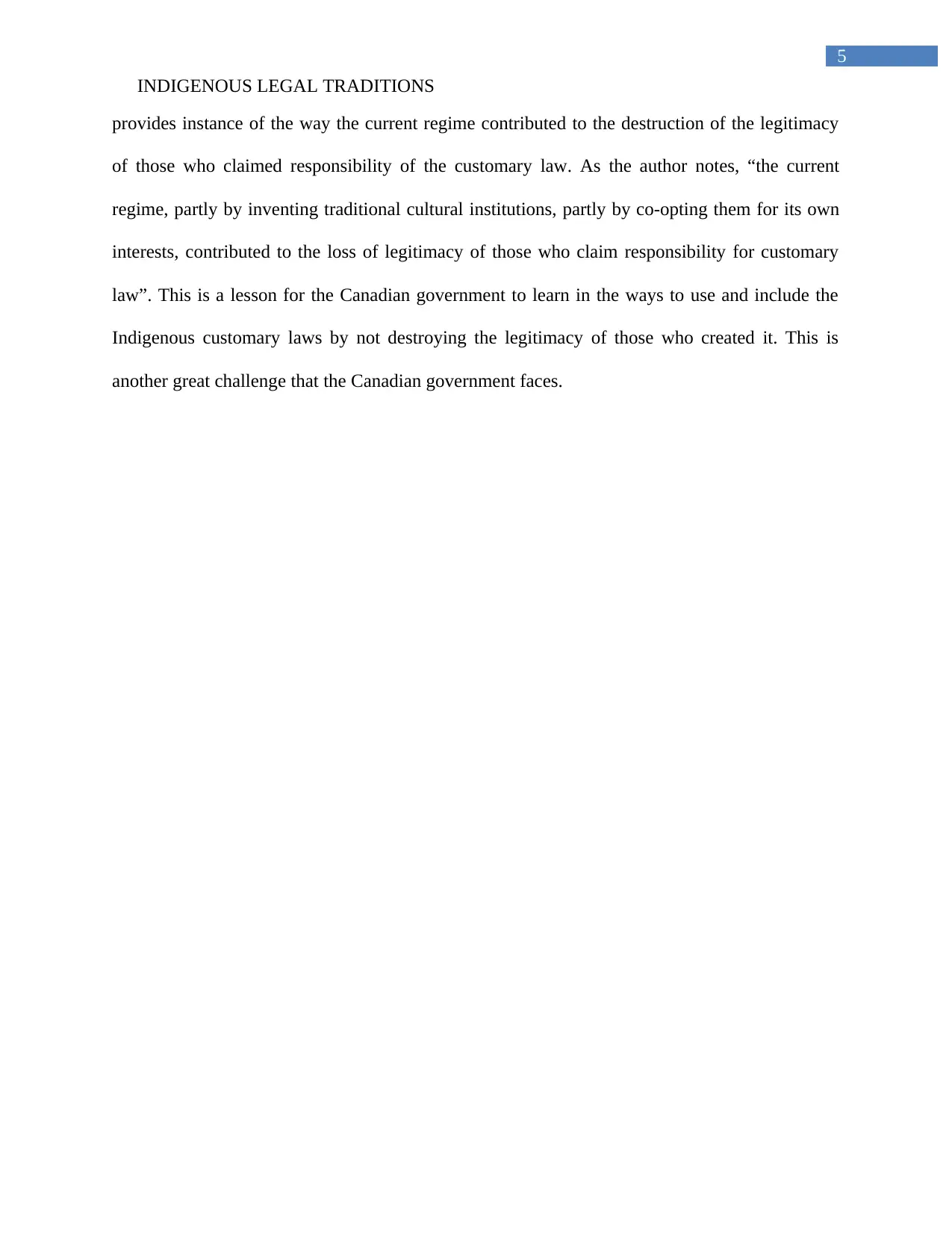
5
INDIGENOUS LEGAL TRADITIONS
provides instance of the way the current regime contributed to the destruction of the legitimacy
of those who claimed responsibility of the customary law. As the author notes, “the current
regime, partly by inventing traditional cultural institutions, partly by co-opting them for its own
interests, contributed to the loss of legitimacy of those who claim responsibility for customary
law”. This is a lesson for the Canadian government to learn in the ways to use and include the
Indigenous customary laws by not destroying the legitimacy of those who created it. This is
another great challenge that the Canadian government faces.
INDIGENOUS LEGAL TRADITIONS
provides instance of the way the current regime contributed to the destruction of the legitimacy
of those who claimed responsibility of the customary law. As the author notes, “the current
regime, partly by inventing traditional cultural institutions, partly by co-opting them for its own
interests, contributed to the loss of legitimacy of those who claim responsibility for customary
law”. This is a lesson for the Canadian government to learn in the ways to use and include the
Indigenous customary laws by not destroying the legitimacy of those who created it. This is
another great challenge that the Canadian government faces.
⊘ This is a preview!⊘
Do you want full access?
Subscribe today to unlock all pages.

Trusted by 1+ million students worldwide
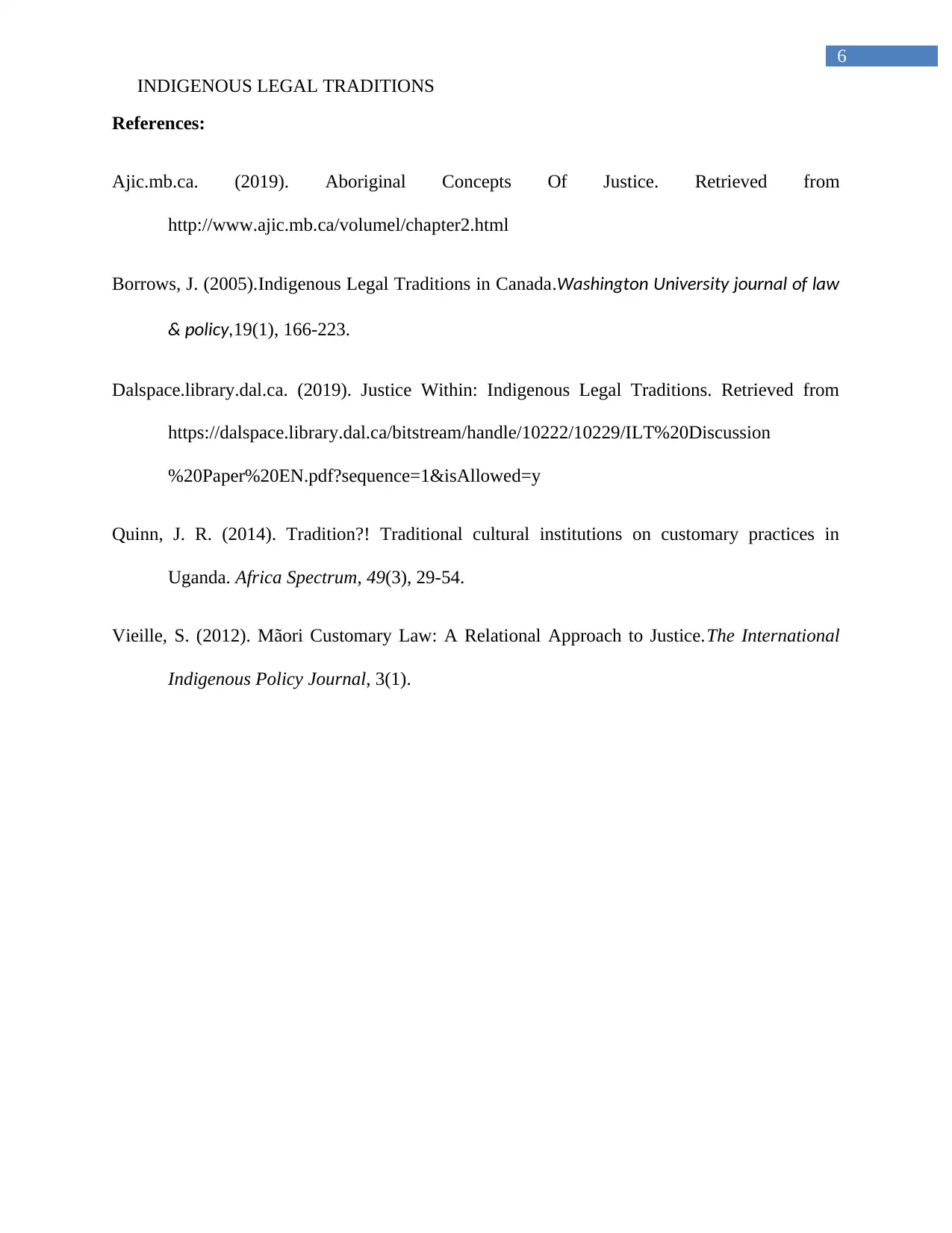
6
INDIGENOUS LEGAL TRADITIONS
References:
Ajic.mb.ca. (2019). Aboriginal Concepts Of Justice. Retrieved from
http://www.ajic.mb.ca/volumel/chapter2.html
Borrows, J. (2005).Indigenous Legal Traditions in Canada.Washington University journal of law
& policy,19(1), 166-223.
Dalspace.library.dal.ca. (2019). Justice Within: Indigenous Legal Traditions. Retrieved from
https://dalspace.library.dal.ca/bitstream/handle/10222/10229/ILT%20Discussion
%20Paper%20EN.pdf?sequence=1&isAllowed=y
Quinn, J. R. (2014). Tradition?! Traditional cultural institutions on customary practices in
Uganda. Africa Spectrum, 49(3), 29-54.
Vieille, S. (2012). Mãori Customary Law: A Relational Approach to Justice.The International
Indigenous Policy Journal, 3(1).
INDIGENOUS LEGAL TRADITIONS
References:
Ajic.mb.ca. (2019). Aboriginal Concepts Of Justice. Retrieved from
http://www.ajic.mb.ca/volumel/chapter2.html
Borrows, J. (2005).Indigenous Legal Traditions in Canada.Washington University journal of law
& policy,19(1), 166-223.
Dalspace.library.dal.ca. (2019). Justice Within: Indigenous Legal Traditions. Retrieved from
https://dalspace.library.dal.ca/bitstream/handle/10222/10229/ILT%20Discussion
%20Paper%20EN.pdf?sequence=1&isAllowed=y
Quinn, J. R. (2014). Tradition?! Traditional cultural institutions on customary practices in
Uganda. Africa Spectrum, 49(3), 29-54.
Vieille, S. (2012). Mãori Customary Law: A Relational Approach to Justice.The International
Indigenous Policy Journal, 3(1).
1 out of 7
Related Documents
Your All-in-One AI-Powered Toolkit for Academic Success.
+13062052269
info@desklib.com
Available 24*7 on WhatsApp / Email
![[object Object]](/_next/static/media/star-bottom.7253800d.svg)
Unlock your academic potential
Copyright © 2020–2025 A2Z Services. All Rights Reserved. Developed and managed by ZUCOL.





